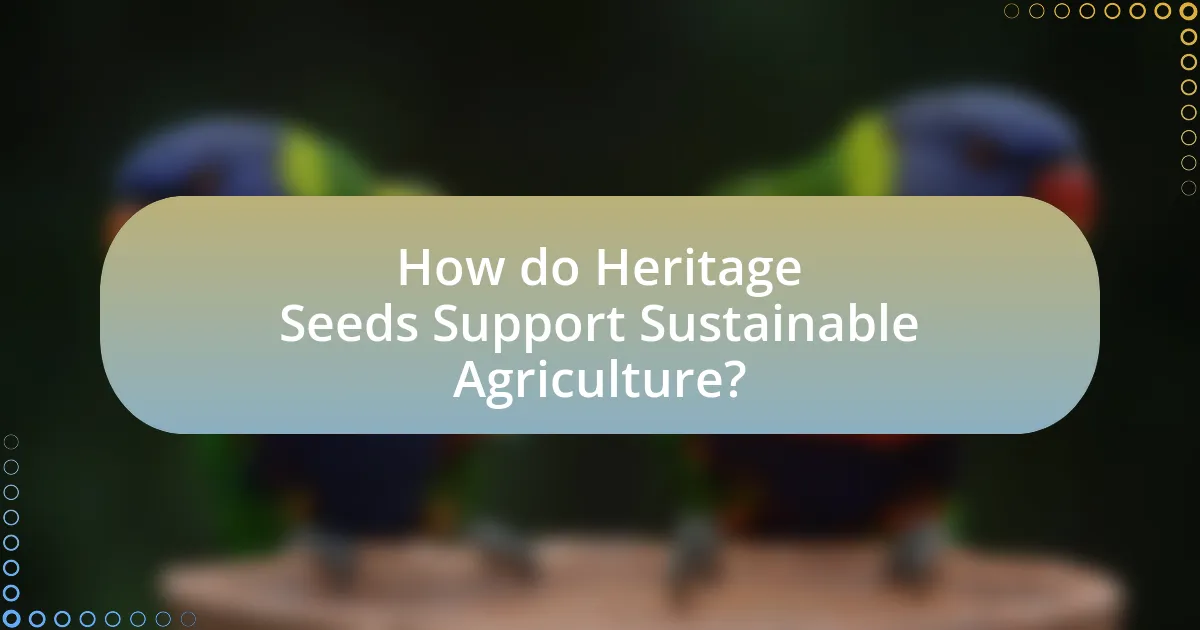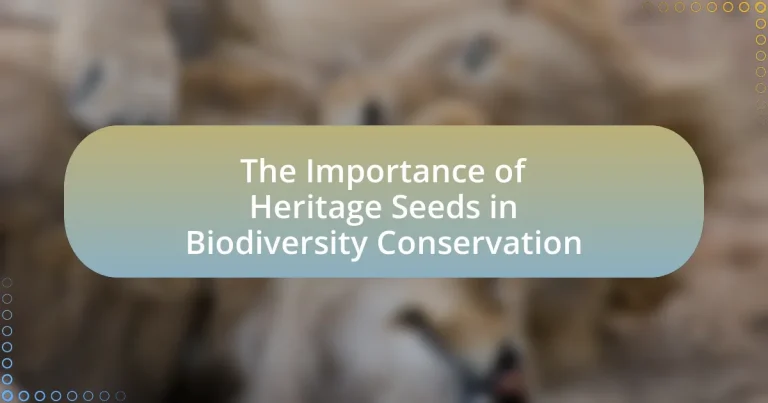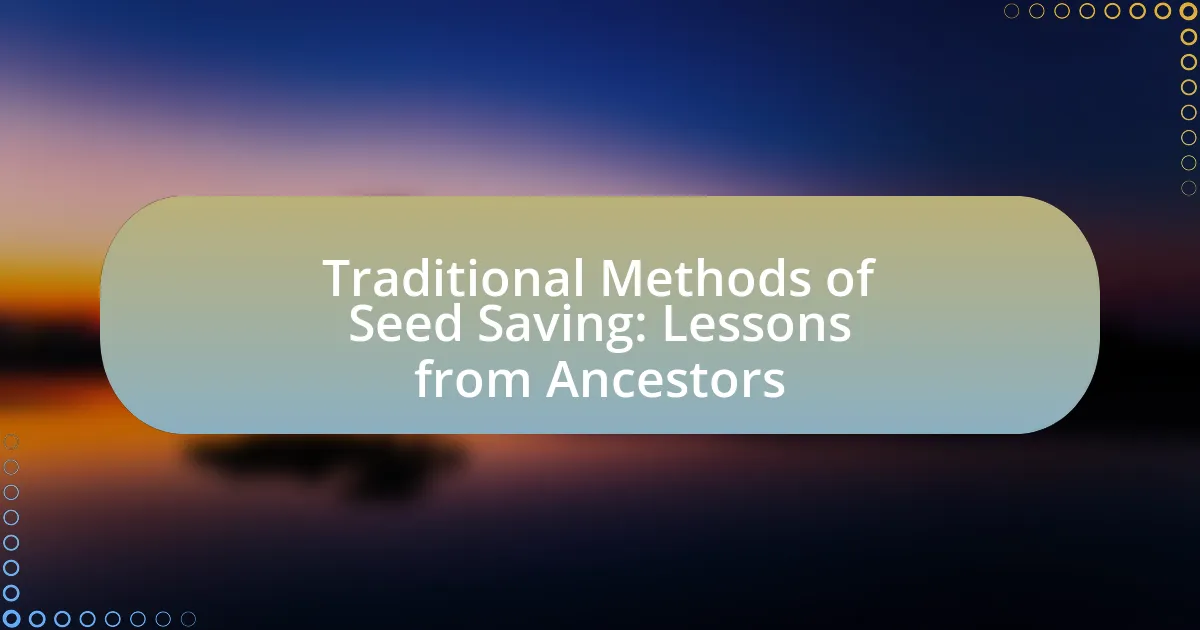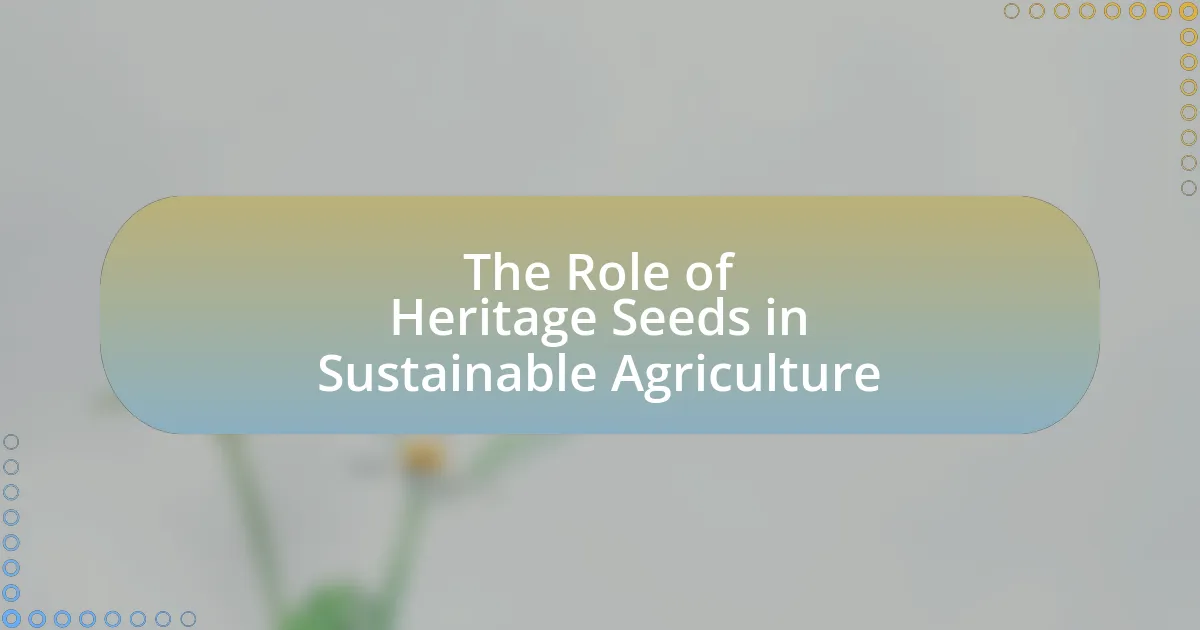Heritage seeds are traditional seed varieties that have been cultivated and passed down through generations, playing a vital role in biodiversity conservation. They maintain genetic diversity, which is essential for ecosystem resilience and adaptability to environmental changes, while also contributing to food security by offering a wide range of crops suited to various climates and soils. This article explores the differences between heritage and modern hybrid seeds, the characteristics that define heritage seeds, their resilience, and their significance in maintaining genetic diversity and ecosystem stability. Additionally, it discusses the environmental benefits of heritage seed cultivation, the challenges they face in modern agriculture, and the practices that support their conservation and sustainable use.

What are Heritage Seeds and Why are They Important for Biodiversity Conservation?
Heritage seeds are traditional varieties of seeds that have been passed down through generations, often cultivated by local farmers and communities. These seeds are important for biodiversity conservation because they maintain genetic diversity, which is crucial for ecosystem resilience and adaptability to changing environmental conditions. Heritage seeds contribute to food security by providing a wide range of crops that can thrive in various climates and soils, thus reducing reliance on a limited number of commercial seed varieties. Additionally, they preserve cultural heritage and agricultural practices, ensuring that unique traits and flavors are retained in our food systems.
How do Heritage Seeds differ from Modern Hybrid Seeds?
Heritage seeds differ from modern hybrid seeds primarily in their genetic makeup and cultivation practices. Heritage seeds are open-pollinated varieties that have been passed down through generations, maintaining genetic diversity and adaptability to local conditions. In contrast, modern hybrid seeds are created through controlled cross-breeding techniques, often resulting in plants that exhibit specific traits but lack the genetic variability found in heritage seeds.
Heritage seeds can be saved and replanted, preserving their lineage, while modern hybrids typically do not produce seeds that are true to type, requiring farmers to purchase new seeds each season. This distinction is crucial for biodiversity conservation, as heritage seeds contribute to a wider gene pool, enhancing resilience against pests and climate change.
What characteristics define Heritage Seeds?
Heritage seeds are defined by their ability to be open-pollinated, which allows them to reproduce true to type in subsequent generations. These seeds are typically non-hybrid and have been passed down through generations, often for at least 50 years, preserving genetic diversity and unique traits. Heritage seeds are also adapted to local growing conditions, making them resilient and well-suited for sustainable agriculture. Their historical significance and contribution to biodiversity conservation are evidenced by their role in maintaining a wide variety of plant genetics, which is crucial for food security and ecological balance.
Why are Heritage Seeds considered more resilient?
Heritage seeds are considered more resilient because they have been cultivated over generations, allowing them to adapt to local environmental conditions and resist pests and diseases. This adaptability is rooted in their genetic diversity, which enhances their ability to thrive in varying climates and soil types. Studies have shown that heritage varieties often outperform modern hybrids in terms of resilience, particularly in organic farming systems, where they demonstrate better resistance to stress factors such as drought and soil degradation.
What role do Heritage Seeds play in maintaining genetic diversity?
Heritage seeds play a crucial role in maintaining genetic diversity by preserving a wide range of plant varieties that have adapted to local environments over generations. These seeds represent the genetic heritage of crops, which is essential for resilience against pests, diseases, and climate change. For instance, heritage seeds can contain unique traits that modern hybrids lack, contributing to a more diverse gene pool. This genetic diversity is vital for food security, as it allows for the development of new varieties that can withstand changing agricultural conditions. Studies have shown that maintaining diverse seed stocks can enhance ecosystem stability and agricultural sustainability, underscoring the importance of heritage seeds in biodiversity conservation.
How do Heritage Seeds contribute to ecosystem stability?
Heritage seeds contribute to ecosystem stability by preserving genetic diversity within plant species. This genetic diversity enhances resilience against pests, diseases, and climate change, allowing ecosystems to adapt and thrive under varying conditions. For instance, a study published in the journal “Biodiversity and Conservation” highlights that diverse crop varieties can better withstand environmental stressors, thereby maintaining ecosystem functions and services. By supporting a wider range of species interactions, heritage seeds play a crucial role in sustaining healthy ecosystems and promoting biodiversity conservation.
What are the implications of losing genetic diversity in crops?
Losing genetic diversity in crops leads to increased vulnerability to pests, diseases, and climate change, ultimately threatening food security. When genetic diversity diminishes, crops become less resilient, as they lack the variety needed to adapt to changing environmental conditions or resist emerging threats. For instance, the Irish Potato Famine in the 1840s exemplifies this risk; the reliance on a single potato variety resulted in widespread crop failure due to a potato blight. Furthermore, reduced genetic diversity can limit agricultural productivity and increase dependency on chemical inputs, as farmers struggle to maintain yields in the face of challenges. This situation underscores the critical need for preserving heritage seeds, which embody a wealth of genetic traits that can enhance resilience and sustainability in agriculture.

How do Heritage Seeds Support Sustainable Agriculture?
Heritage seeds support sustainable agriculture by preserving genetic diversity and promoting resilience in crop production. These seeds, often heirloom varieties, have adapted to local conditions over generations, making them more resistant to pests, diseases, and climate variations. Research indicates that using heritage seeds can enhance soil health and reduce the need for chemical inputs, as these plants often thrive in organic farming systems. For example, a study published in the journal “Agriculture, Ecosystems & Environment” found that farms utilizing heritage seeds showed improved biodiversity and ecosystem services, which are crucial for sustainable agricultural practices.
What practices promote the use of Heritage Seeds in farming?
Practices that promote the use of Heritage Seeds in farming include seed saving, organic farming methods, and community seed banks. Seed saving allows farmers to retain seeds from their best-performing crops, ensuring the continuation of local varieties and enhancing genetic diversity. Organic farming methods, which often emphasize biodiversity and sustainability, create an environment where Heritage Seeds can thrive without synthetic chemicals. Community seed banks facilitate the sharing and preservation of Heritage Seeds, enabling farmers to access diverse genetic resources and fostering local agricultural resilience. These practices collectively support the conservation of biodiversity and the sustainability of agricultural systems.
How can farmers benefit economically from using Heritage Seeds?
Farmers can benefit economically from using Heritage Seeds by reducing input costs and increasing crop resilience. Heritage Seeds are often adapted to local conditions, which can lead to lower reliance on chemical fertilizers and pesticides, ultimately decreasing production costs. Additionally, these seeds can enhance biodiversity on farms, leading to healthier ecosystems that support better yields over time. Research indicates that farms utilizing diverse seed varieties can experience improved soil health and pest resistance, contributing to more sustainable and profitable farming practices. For instance, a study by the Food and Agriculture Organization highlights that diverse cropping systems can yield up to 20% more than monocultures, demonstrating the economic advantages of using Heritage Seeds.
What are the environmental benefits of Heritage Seed cultivation?
Heritage seed cultivation provides significant environmental benefits, primarily by promoting biodiversity and enhancing ecosystem resilience. By preserving a wide variety of plant genetics, heritage seeds contribute to the stability of ecosystems, allowing them to adapt to changing environmental conditions. This genetic diversity is crucial for food security, as it enables crops to withstand pests, diseases, and climate fluctuations. Studies indicate that diverse agricultural systems can lead to improved soil health and reduced reliance on chemical fertilizers and pesticides, which further supports environmental sustainability. Additionally, heritage seeds often require less water and are more suited to local growing conditions, reducing the ecological footprint of agriculture.
Why is the preservation of Heritage Seeds critical for future generations?
The preservation of Heritage Seeds is critical for future generations because it ensures the maintenance of genetic diversity essential for food security and resilience against climate change. Heritage Seeds, often heirloom varieties, possess unique traits that can adapt to varying environmental conditions, which is vital as global climates shift. Studies indicate that over 90% of the world’s food supply comes from just 30 crops, highlighting the risk of relying on a narrow genetic base. By conserving Heritage Seeds, we safeguard a broader genetic pool that can provide essential traits such as drought resistance, pest tolerance, and nutritional value, thereby supporting sustainable agriculture and biodiversity.
What challenges do Heritage Seeds face in modern agriculture?
Heritage seeds face significant challenges in modern agriculture, primarily due to the dominance of hybrid and genetically modified organisms (GMOs). These modern varieties often outperform heritage seeds in yield and disease resistance, leading to a decline in the cultivation of heritage varieties. Additionally, heritage seeds are often less commercially viable because they do not have the same shelf life or market appeal as hybrids, which are bred for uniformity and durability. Furthermore, regulatory hurdles and lack of support from agricultural policies favoring industrial farming practices further marginalize heritage seeds. According to a report by the Food and Agriculture Organization, the loss of traditional varieties threatens agricultural biodiversity, which is crucial for food security and resilience against climate change.
How can communities engage in Heritage Seed conservation efforts?
Communities can engage in Heritage Seed conservation efforts by establishing seed banks and community gardens that focus on preserving local varieties. These initiatives allow community members to collect, store, and share seeds, ensuring genetic diversity and resilience in local agriculture. For example, the Seed Savers Exchange, founded in 1975, has successfully preserved thousands of heirloom varieties through community participation, demonstrating the effectiveness of collective action in seed conservation. Additionally, educational workshops can be organized to raise awareness about the importance of heritage seeds, fostering a culture of conservation and sustainable practices among community members.

What are the Best Practices for Cultivating Heritage Seeds?
The best practices for cultivating heritage seeds include selecting appropriate varieties, ensuring genetic diversity, practicing crop rotation, and maintaining soil health. Selecting heritage seed varieties that are well-suited to local conditions enhances adaptability and resilience. Genetic diversity is crucial as it helps protect against pests and diseases, ensuring a stable yield. Crop rotation prevents soil depletion and reduces pest buildup, while maintaining soil health through organic matter addition and minimal tillage supports robust plant growth. These practices are supported by research indicating that diverse cropping systems can increase resilience and productivity, as highlighted in studies by the Food and Agriculture Organization, which emphasize the role of heritage seeds in sustainable agriculture and biodiversity conservation.
How can gardeners successfully grow Heritage Seeds?
Gardeners can successfully grow Heritage Seeds by ensuring they are planted in nutrient-rich soil, providing adequate water, and maintaining proper spacing for air circulation. Heritage Seeds thrive in well-drained, organic soil that is rich in nutrients, which supports healthy growth and development. Regular watering is essential, particularly during dry spells, as these seeds often come from varieties that may not be as drought-resistant as modern hybrids. Additionally, maintaining proper spacing allows for adequate airflow, reducing the risk of disease and promoting healthy plant growth. Research indicates that Heritage Seeds, which are open-pollinated and often heirloom varieties, can yield better results when grown in conditions that mimic their native environments, thus enhancing biodiversity and resilience in gardens.
What soil and climate conditions are ideal for Heritage Seeds?
Heritage seeds thrive best in well-drained, fertile soils rich in organic matter, with a pH level between 6.0 and 7.5. These seeds prefer climates that offer moderate temperatures, ideally between 60°F and 75°F, along with adequate rainfall or irrigation to maintain moisture without waterlogging. Research indicates that heritage varieties often exhibit resilience to local soil conditions and climate, which enhances their adaptability and biodiversity.
What common pests and diseases should be managed when growing Heritage Seeds?
Common pests that should be managed when growing Heritage Seeds include aphids, spider mites, and whiteflies, while diseases such as powdery mildew, blight, and root rot are also significant concerns. Aphids can transmit viruses and weaken plants, while spider mites cause leaf damage and stress. Whiteflies can lead to stunted growth and reduced yields. Powdery mildew thrives in humid conditions, affecting leaf photosynthesis, and blight can devastate crops by causing rapid decay. Root rot, often caused by overwatering or poor drainage, can lead to plant death. Effective management strategies include crop rotation, the use of resistant varieties, and integrated pest management practices to minimize these threats.
What resources are available for those interested in Heritage Seed conservation?
Resources available for those interested in Heritage Seed conservation include seed banks, educational organizations, and online databases. Seed banks, such as the Seed Savers Exchange, preserve a wide variety of heritage seeds and provide access to them for conservation and cultivation. Educational organizations like the Organic Seed Alliance offer workshops and resources on seed saving techniques and the importance of biodiversity. Additionally, online databases such as the USDA’s National Plant Germplasm System provide information on heritage seed varieties and their conservation status. These resources collectively support the efforts to maintain genetic diversity and promote sustainable agricultural practices.
How can individuals participate in seed saving initiatives?
Individuals can participate in seed saving initiatives by collecting, preserving, and sharing seeds from local plants. This practice helps maintain genetic diversity and supports biodiversity conservation efforts. According to the Seed Savers Exchange, seed saving not only fosters community resilience but also protects heritage varieties that may be at risk of extinction. Engaging in local seed swaps and joining community gardens are effective ways for individuals to contribute to these initiatives, ensuring the continuation of diverse plant species.
What organizations focus on Heritage Seed preservation and education?
Organizations that focus on heritage seed preservation and education include Seed Savers Exchange, the Heritage Seed Library, and the Native Seeds/SEARCH. Seed Savers Exchange, founded in 1975, is dedicated to preserving heirloom seeds and promoting biodiversity through education and community engagement. The Heritage Seed Library, part of Garden Organic in the UK, offers a collection of heritage seeds and provides resources for gardeners to grow and save these seeds. Native Seeds/SEARCH, based in the Southwestern United States, focuses on conserving and promoting traditional agricultural varieties of seeds, particularly those adapted to arid environments. These organizations play a crucial role in maintaining genetic diversity and educating the public about the importance of heritage seeds in sustainable agriculture and biodiversity conservation.
What are the practical steps to start using Heritage Seeds in your garden?
To start using Heritage Seeds in your garden, first, select a variety of Heritage Seeds that are suitable for your climate and soil conditions. Research local seed banks or online retailers that specialize in Heritage Seeds, as these seeds are often open-pollinated and adapted to local environments. Next, prepare your garden soil by ensuring it is well-drained and enriched with organic matter, which supports the growth of diverse plant species.
After soil preparation, plant the Heritage Seeds according to the specific depth and spacing recommendations for each variety, as these factors influence germination and growth. Water the seeds adequately, maintaining consistent moisture without overwatering, which can lead to rot.
Finally, monitor the plants as they grow, providing necessary care such as weeding, mulching, and pest management, while avoiding synthetic chemicals to maintain the integrity of the Heritage Seeds. This approach not only promotes biodiversity but also contributes to the conservation of traditional plant varieties.





